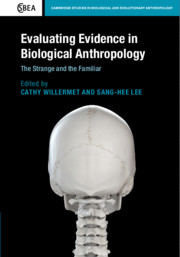Book contents
- Evaluating Evidence in Biological Anthropology
- Cambridge Studies in Biological and Evolutionary Anthropology
- Evaluating Evidence in Biological Anthropology
- Copyright page
- Contents
- Contributors
- Introduction
- Part I The Strange and the Familiar
- Part II (Re)Discovery of Evidence
- 6 (Re)Discovering Paleopathology
- 7 Parsing the Paradox
- 8 Seeing RED
- 9 Paleoanthropology and Analytical Bias
- 10 (Re)Discovering Ancient Hominin Environments
- 11 Discussion and Conclusion
- Index
- References
11 - Discussion and Conclusion
Move Forward, Critically
from Part II - (Re)Discovery of Evidence
Published online by Cambridge University Press: 01 November 2019
- Evaluating Evidence in Biological Anthropology
- Cambridge Studies in Biological and Evolutionary Anthropology
- Evaluating Evidence in Biological Anthropology
- Copyright page
- Contents
- Contributors
- Introduction
- Part I The Strange and the Familiar
- Part II (Re)Discovery of Evidence
- 6 (Re)Discovering Paleopathology
- 7 Parsing the Paradox
- 8 Seeing RED
- 9 Paleoanthropology and Analytical Bias
- 10 (Re)Discovering Ancient Hominin Environments
- 11 Discussion and Conclusion
- Index
- References
Summary
As far as I (Sang-Hee) was concerned, the attraction of biological anthropology was in its scientific approach. The lure of hypothesis testing using empirical data where the only bias to worry about was small sample size was such a powerful position for me, who had been on the humanities track until graduate school. During the 1990s in graduate school I was surprised to find out that the very premise of the scientific approach was questioned by my cohort in cultural anthropology. I quickly dismissed it without engaging in further discussion. Questioning the objectivity and the neutrality of research design was unthinkable.
- Type
- Chapter
- Information
- Evaluating Evidence in Biological AnthropologyThe Strange and the Familiar, pp. 202 - 216Publisher: Cambridge University PressPrint publication year: 2019



